Francesca and Henk-Jan's Backpacking Trip!
Wednesday, June 16, 2010
More Museums In Manila
Hi everyone. Let me just cut into Henk’s post for a second to tell you about my adventures in the two largest (buildings at least) museums in Manila. The National Museum in Manila consisted of two part – the Museum of Filipino People and the National Arts Gallery. Both of the buildings were old, gigantic, and were completely dusty and in need of major renovation. There were very few people visiting the museums (in fact so few they offered free entry for one of them) and it was unclear which of the galleries were even open. Some of them had their lights on but the doors were locked! A few rooms that were opened looked more like storage rooms for objects rather than museum exhibits. Strange. You got the sense that no one cared pretty clearly… what a shame for the artists/researchers.
Anyways, I first explored the Museum of Filipino People. I started with an exhibit on prehistoric pottery which proved pretty boring. There was hardly any information available. There was also a story/exhibit on the excavation of the San Diego shipwreck which had resulted from a famous battle between the Dutch pirate ship named Mauritius and a 115 (35 meter) Spanish galleon named San Diego in the South China Sea off the western Philippines. National Geographic tells us that the ship “… went to the bottom with a rich cargo and most of its 450 men on December 14, 1600 following a botched attempt to commandeer a Dutch pirate ship.” What I saw in the exhibit were artifacts (pottery, coins, cannons, jewels, helmets, etc.) uncovered by divers from this wreck. Apparently, the Spanish trading ship was extremely full – overfull – which resulted in its sinking after ramming the Dutch pirate ship in an attempt to deter the Dutch from taking over their ship.
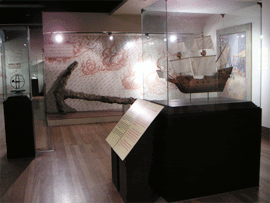
Anyways the exhibit brought me through the different ages of the Philippines starting from the Paleolithic, the Neolithic, Metal, and Ceramic Ages before going into the development of different ethnic groups and their specific cultures in the Philippines, a subject we were pretty familiar with by then. It relayed the volcanic nature of the Philippine islands and how the landscape drastically changed over those periods thus resulting in a continuously nomadic life for humans and diverse animal and plant life as well. There were some model houses and artifacts on display that gave a bit more detail, and there was also another recap of some of the famous festivals from the region we had read about online. I wish I had pictures for you but our camera was dead and my phone’s battery died so there aren’t any. All I have are the ones stolen from their website which should be good enough! Hehe…
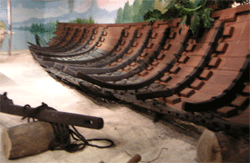
Eventually the food sources were domesticated and metal materials as well as pottery and burial jars became widespread in their use. Trade, and thus interaction with China, increased drastically. The website explains to us:
“A new change took place in the Philippines about 1000 A.D. From the archaeological sites, the age is distinguished by the appearance of high-fired ceramics. This gave proof to the increased maritime trade and cultural contact between the Philippines and her Southeast Asian neighbors. The quantity of Asian trade materials appears to be greater in the southern parts of the country. Underwater archaeological evidences indicate the existence of trade routes that brought the products of the Spice Islands (the Moluccas) up from the South, and the luxuriously manufactured items of China mainland, especially silk and porcelain, directly to Filipino harbors.”
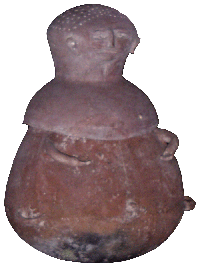
One of the more interesting exhibits in this museum was a dark room filled with burial jars. The look and feel of this area was more than a little creepy, which added to the religious significance of the objects I was looking at. There was a replica of the famous Manunggul jar we read about numerous times on our trip, and later in the day at the National Art Gallery I would actually be face-to-jar with the REAL one!
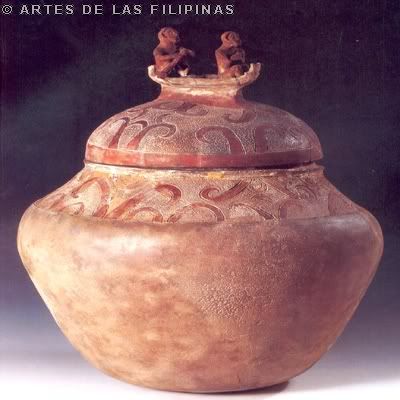
From the museum website:
“The Manunggul jar, one of the most precious jar collections is a secondary burial vessel excavated from a Neolithic burial site in Manunggul cave of Lipuun, Palawan dating from 890-710 B.C. The two prominent figures at the top handle of its cover represent the journey of the soul to the afterworld.
Other funerary vessels associated with the dead in this exhibit are the stone figure from Calatagan, Batangas, the wooden coffin from Banton Island in Romblon, and a unique drinking vessel with a yawning mouth from a late Neolithic site in Leta-leta cave in Palawan.”
Once I went outside I saw a model Ifugao house which I glanced up in and decided it was way too small (and probably damp) for my liking to live in. I continued my walk around the museum exploring a few of the (whoops!) ‘off-limits’ places which included this awesome section on a comic book/superhero artist and some paintings/sculptures from a Filipino art competition. These two exhibits were probably the coolest of the entire museum! Most of the paintings were really strange in their demeanor – the first appeared one way but then upon a second look a new ‘feeling’ came from them. For example, Toti Cerda’s “Broken Vows” has almost an angelic feeling to it at first with its pure white bodies and halos– until you take in the ejaculate on the man’s head and the bruises on the woman’s face. These then evoke a totally different sensation that creeps in and haunts you. Quite interesting! I felt this same feeling with many of the paintings I saw and it seemed almost a theme of the exhibit. See if you can relate to what I’m saying when you see some of these:

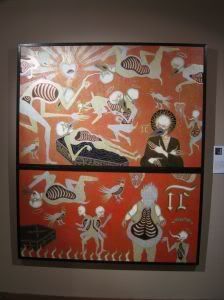
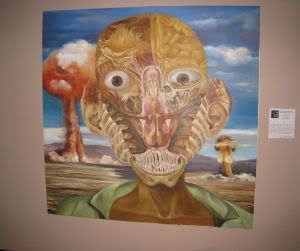
One of the paintings to note was this awesome piece entitled “Mother’s Revenge.” I didn’t realize it at the time but the painting was actually based on Jose Rizal’s sculpture by the same name which I understood once I came across Rizal’s sculpture later that day in the National Art Gallery!
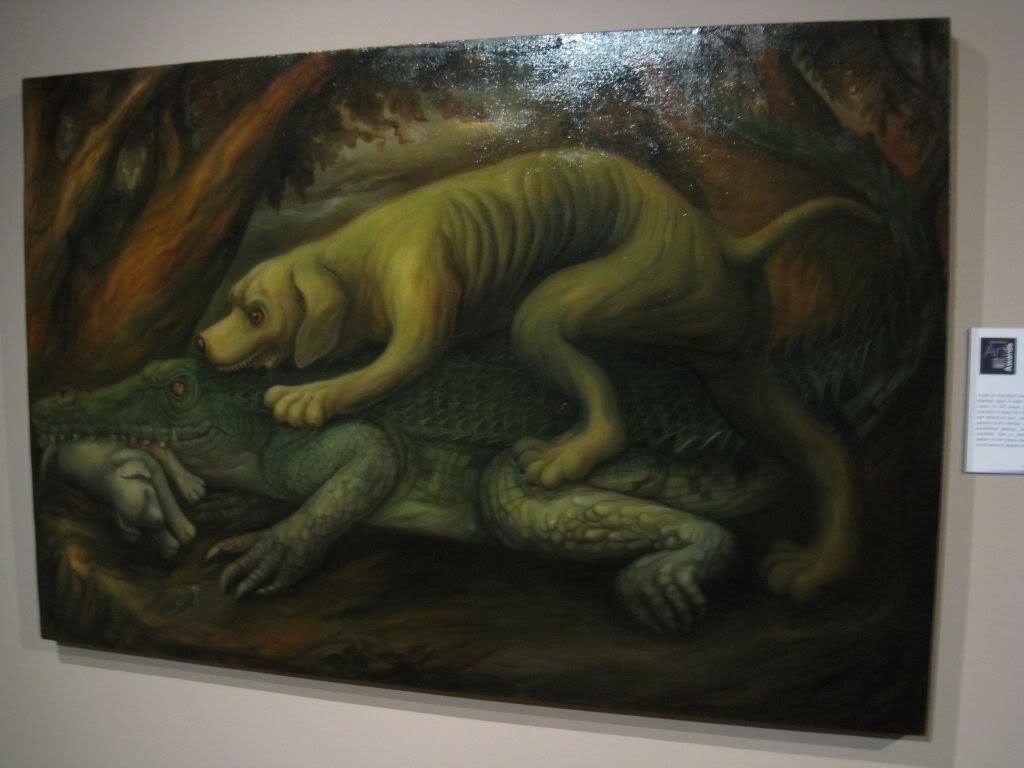

Here is the story of “Mother’s Revenge” as told by WikiPhilipinas:
“Rizal was inspired to create the sculpture by an incident that occurred while he was in Dapitan, where he was deported and set up a school, in 1894. Some of his students secretly went to Dapitan in a boat from Talisay and a puppy of Rizal's dog Syria tried to follow them and was eaten by a crocodile. Rizal scolded the boys, telling them that if they had not gone to town without his permission the puppy would not have died and its mother would have been spared the sorrow of losing an offspring. He further stressed the moral of the incident by making a statuette showing the mother dog killing the crocodile, to avenge her lost puppy. He called this “The Mother’s Revenge.”
The main room at the beginning of the Art Museum was filled with a few gigantic paintings by 19th century Filipino painters Juan Luna and Felix Resurreccion Hidalgo. The website explains that “… Luna's Spoliarium received one of the three gold medals and Hidalgo's Virgenes Cristianas Expuestas al Populacho (Christian Virgins Presented to the Populace) received one of the fourteen silver medals.” I was most impressed by the sheer size of the painting.
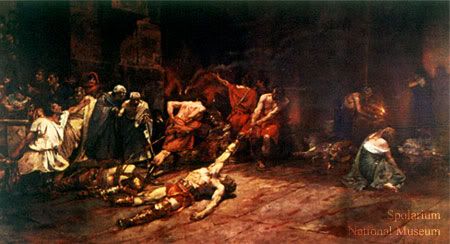
The rest of the galleries turned out to be quite a mixed-mess of things. There was even an old, dusty science exhibit thrown in with a giant whale skeleton. Random! The only other really interesting piece of note was “Tau-Tao” by Roberto Feleo done in 1994 and then re-conceptualized in 1998. This piece was a visual retelling of the Bagobo myth of the afterlife. I found an article in the Leonardo Electronic Almanac by Ma. Corazon A. Hila which explains this well.
“In the Bagobo origin myth, Mebuyan is herself one of three children, the other two being Wari and Lumabat - of Tuglay and Tuglibong, the original man and woman said to have been shaped from two lumps of earth and given life by the goddess Diwata. Mebuyan and these other characters of the Bagobo myth form the subjects of Feleo's "Tau-Tao" series, subtitled "A Retelling of the Bagobo Myth of the Afterlife."
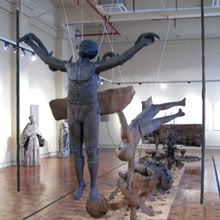
A second version of the Mebuyan, also featured in the 1998 "Tau-Tao" series, conveys the wrathful side of the goddess. Thus, if the "Inakay Mebuyan" nurtures and gives life, "Ang Mapanghasik na Mebuyan" (completed in 1997) destroys and takes it away. In this work, a male figure is shown lying stiff on a leaf that has just fallen to the ground from the vigorous shaking of the kalamansi tree, the goddess' way of claiming life. Through these contrasting images of life and death, Feleo questions our conventional notions of ourselves and confronts us with our hidden fears and anxieties, especially regarding our mortality and power, or the lack of it, over our life, over things, over people. The binura technique in fact makes for an effective metaphor for the act of slowly coming to terms with ourselves, with our nature, with our archetypal past.”
After I finished with the museums I headed outside to grab a taxi. But wow that was a much more horrible experience than I ever predicted. It was dreadfully hot outside and I was starting to get a bad headache (as I always due in the heat) so I was very eager to get transport back to the hostel to meet Henk. Plus since the phone had died I had no idea what time it was and I knew we had to catch our flight later that day. After more than an hour of going up and down the streets (even asking the cops for help… and they were of course no help) trying to get a taxi a kind elderly Filipino man helped me get one. (Which still took us a good 20 minutes longer after I got his help!) I’m not sure why but NEVER go to the museums during lunchtime. I honestly think everyone in the city must go to sleep and travelers get screwed over. Anyways… back to Henk’s story now!
Anyways, I first explored the Museum of Filipino People. I started with an exhibit on prehistoric pottery which proved pretty boring. There was hardly any information available. There was also a story/exhibit on the excavation of the San Diego shipwreck which had resulted from a famous battle between the Dutch pirate ship named Mauritius and a 115 (35 meter) Spanish galleon named San Diego in the South China Sea off the western Philippines. National Geographic tells us that the ship “… went to the bottom with a rich cargo and most of its 450 men on December 14, 1600 following a botched attempt to commandeer a Dutch pirate ship.” What I saw in the exhibit were artifacts (pottery, coins, cannons, jewels, helmets, etc.) uncovered by divers from this wreck. Apparently, the Spanish trading ship was extremely full – overfull – which resulted in its sinking after ramming the Dutch pirate ship in an attempt to deter the Dutch from taking over their ship.

Anyways the exhibit brought me through the different ages of the Philippines starting from the Paleolithic, the Neolithic, Metal, and Ceramic Ages before going into the development of different ethnic groups and their specific cultures in the Philippines, a subject we were pretty familiar with by then. It relayed the volcanic nature of the Philippine islands and how the landscape drastically changed over those periods thus resulting in a continuously nomadic life for humans and diverse animal and plant life as well. There were some model houses and artifacts on display that gave a bit more detail, and there was also another recap of some of the famous festivals from the region we had read about online. I wish I had pictures for you but our camera was dead and my phone’s battery died so there aren’t any. All I have are the ones stolen from their website which should be good enough! Hehe…

Eventually the food sources were domesticated and metal materials as well as pottery and burial jars became widespread in their use. Trade, and thus interaction with China, increased drastically. The website explains to us:
“A new change took place in the Philippines about 1000 A.D. From the archaeological sites, the age is distinguished by the appearance of high-fired ceramics. This gave proof to the increased maritime trade and cultural contact between the Philippines and her Southeast Asian neighbors. The quantity of Asian trade materials appears to be greater in the southern parts of the country. Underwater archaeological evidences indicate the existence of trade routes that brought the products of the Spice Islands (the Moluccas) up from the South, and the luxuriously manufactured items of China mainland, especially silk and porcelain, directly to Filipino harbors.”

One of the more interesting exhibits in this museum was a dark room filled with burial jars. The look and feel of this area was more than a little creepy, which added to the religious significance of the objects I was looking at. There was a replica of the famous Manunggul jar we read about numerous times on our trip, and later in the day at the National Art Gallery I would actually be face-to-jar with the REAL one!

From the museum website:
“The Manunggul jar, one of the most precious jar collections is a secondary burial vessel excavated from a Neolithic burial site in Manunggul cave of Lipuun, Palawan dating from 890-710 B.C. The two prominent figures at the top handle of its cover represent the journey of the soul to the afterworld.
Other funerary vessels associated with the dead in this exhibit are the stone figure from Calatagan, Batangas, the wooden coffin from Banton Island in Romblon, and a unique drinking vessel with a yawning mouth from a late Neolithic site in Leta-leta cave in Palawan.”
Once I went outside I saw a model Ifugao house which I glanced up in and decided it was way too small (and probably damp) for my liking to live in. I continued my walk around the museum exploring a few of the (whoops!) ‘off-limits’ places which included this awesome section on a comic book/superhero artist and some paintings/sculptures from a Filipino art competition. These two exhibits were probably the coolest of the entire museum! Most of the paintings were really strange in their demeanor – the first appeared one way but then upon a second look a new ‘feeling’ came from them. For example, Toti Cerda’s “Broken Vows” has almost an angelic feeling to it at first with its pure white bodies and halos– until you take in the ejaculate on the man’s head and the bruises on the woman’s face. These then evoke a totally different sensation that creeps in and haunts you. Quite interesting! I felt this same feeling with many of the paintings I saw and it seemed almost a theme of the exhibit. See if you can relate to what I’m saying when you see some of these:



One of the paintings to note was this awesome piece entitled “Mother’s Revenge.” I didn’t realize it at the time but the painting was actually based on Jose Rizal’s sculpture by the same name which I understood once I came across Rizal’s sculpture later that day in the National Art Gallery!


Here is the story of “Mother’s Revenge” as told by WikiPhilipinas:
“Rizal was inspired to create the sculpture by an incident that occurred while he was in Dapitan, where he was deported and set up a school, in 1894. Some of his students secretly went to Dapitan in a boat from Talisay and a puppy of Rizal's dog Syria tried to follow them and was eaten by a crocodile. Rizal scolded the boys, telling them that if they had not gone to town without his permission the puppy would not have died and its mother would have been spared the sorrow of losing an offspring. He further stressed the moral of the incident by making a statuette showing the mother dog killing the crocodile, to avenge her lost puppy. He called this “The Mother’s Revenge.”
The main room at the beginning of the Art Museum was filled with a few gigantic paintings by 19th century Filipino painters Juan Luna and Felix Resurreccion Hidalgo. The website explains that “… Luna's Spoliarium received one of the three gold medals and Hidalgo's Virgenes Cristianas Expuestas al Populacho (Christian Virgins Presented to the Populace) received one of the fourteen silver medals.” I was most impressed by the sheer size of the painting.

The rest of the galleries turned out to be quite a mixed-mess of things. There was even an old, dusty science exhibit thrown in with a giant whale skeleton. Random! The only other really interesting piece of note was “Tau-Tao” by Roberto Feleo done in 1994 and then re-conceptualized in 1998. This piece was a visual retelling of the Bagobo myth of the afterlife. I found an article in the Leonardo Electronic Almanac by Ma. Corazon A. Hila which explains this well.
“In the Bagobo origin myth, Mebuyan is herself one of three children, the other two being Wari and Lumabat - of Tuglay and Tuglibong, the original man and woman said to have been shaped from two lumps of earth and given life by the goddess Diwata. Mebuyan and these other characters of the Bagobo myth form the subjects of Feleo's "Tau-Tao" series, subtitled "A Retelling of the Bagobo Myth of the Afterlife."

A second version of the Mebuyan, also featured in the 1998 "Tau-Tao" series, conveys the wrathful side of the goddess. Thus, if the "Inakay Mebuyan" nurtures and gives life, "Ang Mapanghasik na Mebuyan" (completed in 1997) destroys and takes it away. In this work, a male figure is shown lying stiff on a leaf that has just fallen to the ground from the vigorous shaking of the kalamansi tree, the goddess' way of claiming life. Through these contrasting images of life and death, Feleo questions our conventional notions of ourselves and confronts us with our hidden fears and anxieties, especially regarding our mortality and power, or the lack of it, over our life, over things, over people. The binura technique in fact makes for an effective metaphor for the act of slowly coming to terms with ourselves, with our nature, with our archetypal past.”
After I finished with the museums I headed outside to grab a taxi. But wow that was a much more horrible experience than I ever predicted. It was dreadfully hot outside and I was starting to get a bad headache (as I always due in the heat) so I was very eager to get transport back to the hostel to meet Henk. Plus since the phone had died I had no idea what time it was and I knew we had to catch our flight later that day. After more than an hour of going up and down the streets (even asking the cops for help… and they were of course no help) trying to get a taxi a kind elderly Filipino man helped me get one. (Which still took us a good 20 minutes longer after I got his help!) I’m not sure why but NEVER go to the museums during lunchtime. I honestly think everyone in the city must go to sleep and travelers get screwed over. Anyways… back to Henk’s story now!

0 Comments:
Post a Comment
<< Home